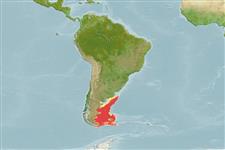Preferred temperature (Réf.
123201): 4.5 - 9, mean 6 °C (based on 192 cells).
Phylogenetic diversity index (Réf.
82804): PD
50 = 0.5000 [Uniqueness, from 0.5 = low to 2.0 = high].
Bayesian length-weight: a=0.00589 (0.00282 - 0.01229), b=3.23 (3.05 - 3.41), in cm total length, based on LWR estimates for this (Sub)family-body shape (Ref.
93245).
Niveau trophique (Réf.
69278): 3.7 ±0.51 se; based on food items.
Résilience (Réf.
120179): Milieu, temps minimum de doublement de population : 1,4 à 4,4 années (K=0.22-0.35; assuming fec < 10,000).
Prior r = 0.57, 95% CL = 0.37 - 0.85, Based on 1 data-limited stock assessment.
Fishing Vulnerability (Ref.
59153): Moderate vulnerability (37 of 100).
🛈
Climate Vulnerability (Ref.
125649): Moderate vulnerability (44 of 100).
🛈
Nutrients (Ref.
124155): Calcium = 24.8 [15.4, 42.3] mg/100g; Iron = 0.274 [0.174, 0.443] mg/100g; Protein = 17.8 [16.5, 19.0] %; Omega3 = 0.694 [0.411, 1.164] g/100g; Selenium = 19.3 [10.1, 35.8] μg/100g; VitaminA = 20.8 [6.4, 63.6] μg/100g; Zinc = 0.577 [0.432, 0.801] mg/100g (wet weight); based on
nutrient studies. 